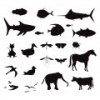Heart rate decreases during diving in seals and other animals. Thus the ascending aorta becomes very important during diving as it helps to maintain blood pressure during prolonged dives. A new study published in the American Journal of Physiology - Regulatory, Integrative and Comparative Physiology was designed to examine the ascending aorta of hooded seals (Cystophora cristata) and the tiny blood vessels that supply nutrients to it, called the vasa vasorum.
The ascending aorta of the hooded seal is about 3-5mm thick. Microscopic images taken in the study showed openings to the vasa vasorum from the lumen of the aorta that extend into a network of tiny blood vessels on the external surface. This network of blood vessels appears to be important in supplying nutrients and oxygen to the thick wall of the aorta. It is unknown whether a similar vasa vasorum network is present in humans. If so, disorders such as atherosclerosis may block the openings to these vessels and thus contribute to oxygen deprivation of the vessel wall and possibly the development of aneurysms.
Sources:
Blix AS, Kuttner S, Messelt EB. The ascending aorta of hooded seals with particular emphasis on its vasa vasorum. American Journal of Physiology - Regulatory, Integrative and Comparative Physiology. [Epub ahead of print] doi: 10.1152/ajpregu.00070.2016.
